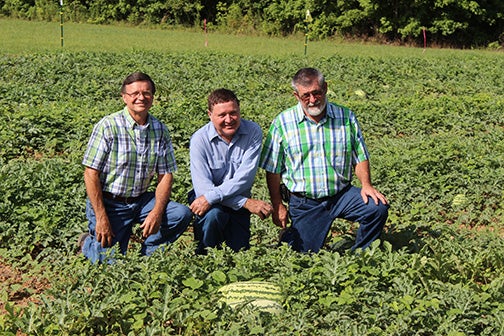Time for Water Valley melons
Published 12:00 pm Monday, July 25, 2016

- Watermelon farmers Will Pullen, Joe Pullen and Dalton Rogers grow melons for the upcoming Watermelon Carnival, which is held on the fist weekend in August.
By Allen Brewer
news@oxfordeagle.com
Water Valley grown watermelons are just about ready for the picking and the eating as the annual Watermelon Carnival quickly approaches. Though the weather has not been so favorable for this year’s crop, local farmers are hopeful recent rains will boost their melon’s growth in time for harvest.
“They like a fair amount of fertilizer and moisture,” Water Valley farmer Joe Newman, said. “It’s about half water and half fertilizer to get the perfect start with a good seed.”
Newman is known for supplying melons to the B.T.C. Grocery in Water Valley and won second place one year for growing the second largest melon in the Watermelon Carnival.
“I grow them because I like them,” Newman said. “I love to see a truck full of watermelons.”
Growing melons
Watermelons are members of the melon family, and like cantaloupe and honeydew, thrive in hot, wet climates like Mississippi. To make sure these plants have time to grow in the right season, farmers start planting their melons in April and May.
The first sign that the watermelon is beginning to grow is the small sprouts that break through the ground then lay over around the time of its third leaf. Like a squash, a watermelon flowers with a yellow blossom with a small “shape” behind the flower. The round shape will become the watermelon fruit that will expand and change into the iconic food as it matures.
There are many different types of watermelons varying in size, color, shape and meat color. This year, Newman is growing Moon and Stars, a large type of melon with one large yellow spot — the sun — and other smaller spots — the stars — displayed on its rind.
In recent years, the Carolina Cross has become a favorite for the Watermelon Carnival contest due to its large size; some reaching up to 250 pounds. These large melons aren’t necessarily meant for eating, but are highly prized for their girth.
Local farmers Joe Pullen, William Pullen and Dalton Rogers, are growing 3-acres of watermelons this year for the Watermelon Carnival. These men have been selling melons for the last 50 years and have become known for their produce.
“We have done this so long, when people come to the carnival they ask for a Pullen watermelon,” Will Pullen said.
They say a plethora of pests have been affecting this year’s crop of melons including raccoons, crows and coyotes. To keep out the unwanted guest, farmers use electric fences, plastic bags and scarecrows to protect their crop.
Morning Glories; however, seem to avoid such obstacles and are obsessively sneaking into the garden. If unwatched, these flowering weeds will grow above the melons and block the melon’s sun.
Despite these challenges, Joe Pullen estimates that they will get about 700 melons from their patch. The group plans to sell half of their melons in the carnival and give the rest away to family and friends. They also hope to donate some melons to the members of the Yalobusha Nursing Home.
“We give out just as much as we sale,” Rogers said.
The most important part of growing watermelons; however, is the way you eat them. Watermelons make sweet, watery treats to eat in the heat of the day. They are also good for seed spitting competitions that can entertain one all day.
“I like to eat them raw, preferably fresh from the patch early in the morning after I pick them,” Newman said. “I just lay it on my tail gate and split it open and eat it right there.”
No matter what time of day it is, watermelons are a tasty food many around the world enjoy.
“I like to cut mine up and put them in a Zip-lock bags and put them in the refrigerator,” Joe Pullen said. “I like to eat them with my meal, with or without salt.”





